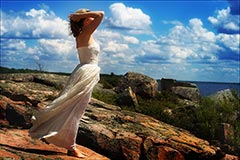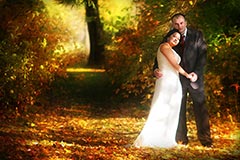Professional Wedding Portraits by studioEPIC photography - Toronto, Ontario (images below)
For bookings and/or inquiries call 416.554.3742.
For rates click here.
For centuries people have been projecting images onto surfaces. Some contemporary scholars believe this was done as early as the 16th century. Some, even though disputed, even believe that early artists used camera like devices to project images onto surfaces for tracing.
Photography in its true sense of capturing images did not start until the early 1800s. The first photo was produced by a French inventor Nicéore Niée on a copper plate covered with a petroleum derivative (Bitumen). This photo required an eight our exposure in bright sunlight. The earliest surviving photo is from 1826 and it was taken by this French inventor.
Various refinements of photographic technique lead to its popularization in the late 1800s. The industrial revolution and the requirement to product portraits quickly and easily (in comparison to the traditional oil painting) put additional pressure on the industry to refine the process and by around 1880 a studio portrait photography would cost about $1000 USD in 2006 dollars. At approximately that point wedding photography became an accepted form of commercial art. At first all wedding photographs, due to the limitations of technology and the amount of photographic equipment necessary were taken in the studio.
One limitation of early wedding photography was that there was no way of making copies of taken photographs. The photos were exposed on a small copper sheet. Additional changes in technology brought about new ways of capturing images, this included glass plates, tin and copper plates and sheet. In 1884 George Eastman of Rochester, New York developed a dry gel on paper process. This was the first time that photographers could leave the studio without having to carry loads of plates, heavy equipment and dangerous chemicals, also at this time we have the first historical records of early wedding photographers taking photos on location. With the new century came the introduction of color photography. This was achieved by combining various chemicals which responded differently to various wavelengths of light into one mixture in such a way that color would be captured on the surface. This process however, was very unpredictable and even though the original results were pleasing, the colors faded quickly. Between 1907 and 1936 various color films with increasing quality reached the market. In 1936, German photographic firm Agfa released the Agfacolor Neue film. This film is the basis for most modern day photographic films. After World War Two the 'Wedding Boom' and relative affordability gave rise to the first common wedding photography market. It became common place for engaged couples to have photographs taken before and during the wedding ceremony. An interesting phenomenon of those times was the fact that photographers would show up to the wedding unannounced, use their photographic roll film and compact portable flash tubes to take photos of the couple and then try to sell their photos after the event. The 'flash' photographers were at first militarily trained personnel looking to make additional money after the war, however this quickly changed and amateur photographers took up this activity as well. This forced trained studio photographer to go mobile as well, and by the 1950s this practice ceased to exists and the current day, pre-booked wedding photographers became the standard. The next significant change was the invention of the 35mm camera and the subsequent invention of the 'Wedding Photojournalist'. These new smaller cameras were portable enough to be used by journalists in the field and Wedding Photographers took the clue from professional photojournalists and started taking candid shots, known as the photojournalistic style. The next significant change was the invention of the auto focus which further simplified the art of wedding photography. Most recently Wedding Photography has undergone a monumental shift with the invention of the digital camera. What first started as the fringe industry of the digital wedding photographer recently became the norm. As the camera companies began to discontinue film cameras more and more Wedding Photographers switched into digital, leaving mostly the more traditional medium format wedding photographers shooting with Film.
Photography in its true sense of capturing images did not start until the early 1800s. The first photo was produced by a French inventor Nicéore Niée on a copper plate covered with a petroleum derivative (Bitumen). This photo required an eight our exposure in bright sunlight. The earliest surviving photo is from 1826 and it was taken by this French inventor.
Various refinements of photographic technique lead to its popularization in the late 1800s. The industrial revolution and the requirement to product portraits quickly and easily (in comparison to the traditional oil painting) put additional pressure on the industry to refine the process and by around 1880 a studio portrait photography would cost about $1000 USD in 2006 dollars. At approximately that point wedding photography became an accepted form of commercial art. At first all wedding photographs, due to the limitations of technology and the amount of photographic equipment necessary were taken in the studio.
One limitation of early wedding photography was that there was no way of making copies of taken photographs. The photos were exposed on a small copper sheet. Additional changes in technology brought about new ways of capturing images, this included glass plates, tin and copper plates and sheet. In 1884 George Eastman of Rochester, New York developed a dry gel on paper process. This was the first time that photographers could leave the studio without having to carry loads of plates, heavy equipment and dangerous chemicals, also at this time we have the first historical records of early wedding photographers taking photos on location. With the new century came the introduction of color photography. This was achieved by combining various chemicals which responded differently to various wavelengths of light into one mixture in such a way that color would be captured on the surface. This process however, was very unpredictable and even though the original results were pleasing, the colors faded quickly. Between 1907 and 1936 various color films with increasing quality reached the market. In 1936, German photographic firm Agfa released the Agfacolor Neue film. This film is the basis for most modern day photographic films. After World War Two the 'Wedding Boom' and relative affordability gave rise to the first common wedding photography market. It became common place for engaged couples to have photographs taken before and during the wedding ceremony. An interesting phenomenon of those times was the fact that photographers would show up to the wedding unannounced, use their photographic roll film and compact portable flash tubes to take photos of the couple and then try to sell their photos after the event. The 'flash' photographers were at first militarily trained personnel looking to make additional money after the war, however this quickly changed and amateur photographers took up this activity as well. This forced trained studio photographer to go mobile as well, and by the 1950s this practice ceased to exists and the current day, pre-booked wedding photographers became the standard. The next significant change was the invention of the 35mm camera and the subsequent invention of the 'Wedding Photojournalist'. These new smaller cameras were portable enough to be used by journalists in the field and Wedding Photographers took the clue from professional photojournalists and started taking candid shots, known as the photojournalistic style. The next significant change was the invention of the auto focus which further simplified the art of wedding photography. Most recently Wedding Photography has undergone a monumental shift with the invention of the digital camera. What first started as the fringe industry of the digital wedding photographer recently became the norm. As the camera companies began to discontinue film cameras more and more Wedding Photographers switched into digital, leaving mostly the more traditional medium format wedding photographers shooting with Film.


























































